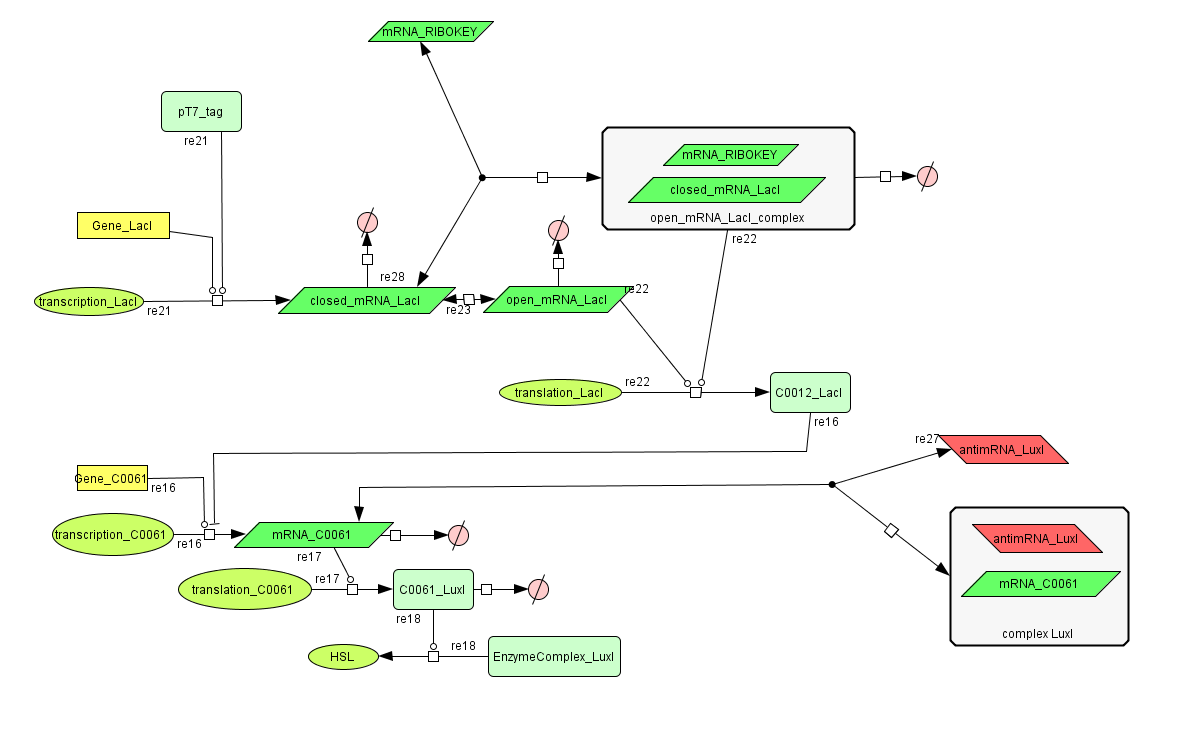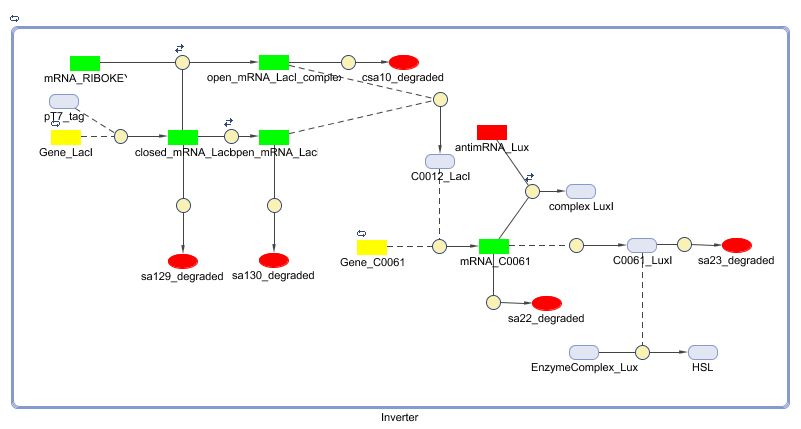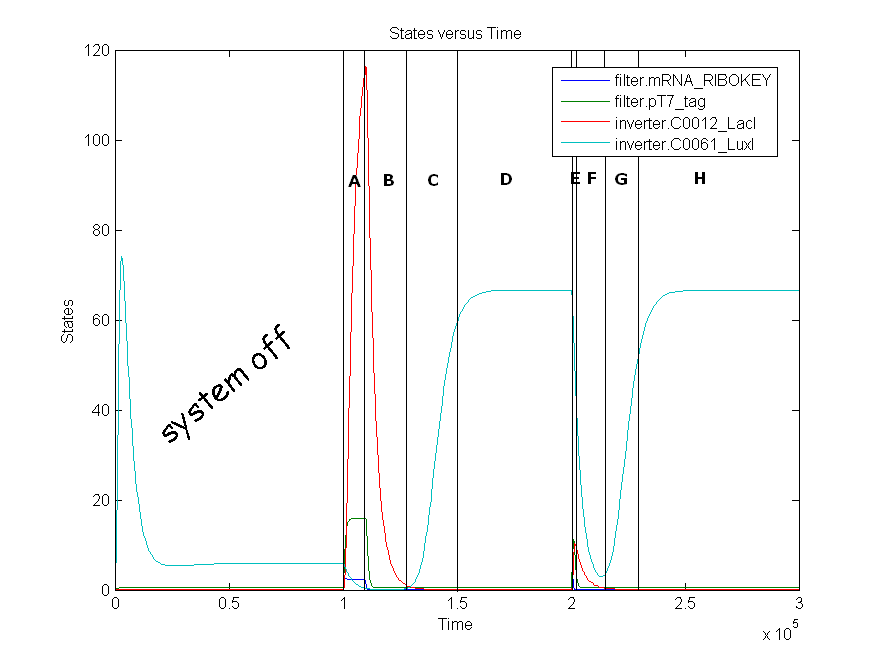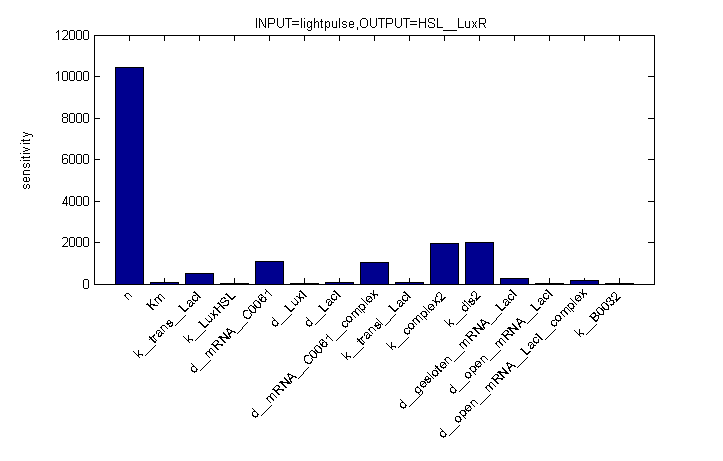Team:KULeuven/Model/Inverter
From 2008.igem.org
(Difference between revisions)
(→Simulations) |
m (→Simulations) |
||
| Line 188: | Line 188: | ||
| A | | A | ||
| 0.0125 | | 0.0125 | ||
| - | | The amount LacI increases from state zero to state one because both mRNA_RIBOKEY and pT7_tag are present. This results in a repression of LuxI which decreases to zero. | + | | The amount LacI increases from state zero to state one because both mRNA_RIBOKEY and pT7_tag are present. This results in a repression of LuxI which decreases to zero: the input signal (TetR) is inverted. |
|- | |- | ||
| B | | B | ||
| 5E-5 | | 5E-5 | ||
| - | | | + | | The amount LacI decreases back to state zero. The amount LuxI remains the same (state zero). |
|- | |- | ||
| C | | C | ||
| 5E-5 | | 5E-5 | ||
| - | | | + | | LuxI changes from state zero to state one. Time span B and C form together the transient behaviour of the inverter when the input signal changes from one to zero. |
|- | |- | ||
| D | | D | ||
| 5E-5 | | 5E-5 | ||
| - | | | + | | LuxI remains in state one: the input signal is once again inverted. |
|- | |- | ||
| E | | E | ||
| 0.0125 | | 0.0125 | ||
| - | | | + | | A short pulse of 1000 seconds has a influence a steep decrease of LuxI. |
|- | |- | ||
| - | | F | + | | F & G |
| 5E-5 | | 5E-5 | ||
| - | | | + | | During time span F and G, LuxI decreases further for a while and increases back to state one. |
| - | + | ||
| - | + | ||
| - | + | ||
| - | + | ||
|- | |- | ||
| H | | H | ||
| 5E-5 | | 5E-5 | ||
| - | | | + | | LuxI is back in state one. |
|} | |} | ||
| + | The simulation shows a working inverter. A small disadvantage is the transient behaviour of the inverter: a small pulse of 1000 seconds results in a transient behaviour of +- 30000 seconds. Also for a long pulse (10000 seconds) is a long transient behaviour noticeable (40000 seconds). | ||
| - | + | [[Image:Sim_inverter_1.png|500px|center|inverter]] | |
| - | + | ||
| - | + | ||
| - | [[Image:Sim_inverter_1.png| | + | |
=== Sensitivity Analysis === | === Sensitivity Analysis === | ||
[[Image:Sens Inverter.png|center]] | [[Image:Sens Inverter.png|center]] | ||
Revision as of 13:21, 8 September 2008
dock/undock dropdown
Contents |
Invertimer
Position in the system
The invertimer subsystem receives its input from the filter, T7. The invertimer's function is to produce HSL when no input is present, so a low T7 input gives rise to a high HSL output and vice versa. The production of HSL means that the cell will start a timer that eventually will be used in the celldeath-subsystem to produce ccdB. In this way the cell will die off if no desease remains present.
Describing the system
see also: Project:Invertimer
ODE's
Parameters
| Name | Value | Comments | Reference |
|---|---|---|---|
| Degradation Rates | |||
| dLuxI | dLVA = 2.814E-4 s-1 | LVA-tag reduces lifetime to 40 minutes | [http://parts.mit.edu/igem07/index.php/ETHZ/Parameters link] [http://www.pubmedcentral.nih.gov/articlerender.fcgi?artid=106306 link] |
| dRNA_LuxI | 0.0025 s-1 | [http://www.pubmedcentral.nih.gov/picrender.fcgi?artid=124983&blobtype=pdf link] | |
| dLuxI_antimRNA | 0.0045303737 s-1 | estimate: because this RNA isn't translated, it degrades faster | |
| dLacI | dLVA = 2.814E-4 s-1 | LVA-tag reduces lifetime to 40 minutes | [http://parts.mit.edu/igem07/index.php/ETHZ/Parameters link] [http://www.pubmedcentral.nih.gov/articlerender.fcgi?artid=106306 link] |
| dclosed mRNA LacI | 0.0046209812 s-1 | estimate: because this mRNA isn't translated, it degrades faster | |
| dopen mRNA LacI | 0.0023104906 s-1 | [http://www.pubmedcentral.nih.gov/picrender.fcgi?artid=124983&blobtype=pdf link] | |
| dopen mRNA LacI complex | 0.0023104906 s-1 | [http://www.pubmedcentral.nih.gov/picrender.fcgi?artid=124983&blobtype=pdf link] | |
| dHSL | 1.02E-6 s-1 | very stable in the medium, lifetime around 185h | [http://aem.asm.org/cgi/content/abstract/71/3/1291 link] |
| LuxI catalysis | |||
| kcat | 0.0166666667 s-1 | Estimated to be about 90% of Vmax in LB medium. | [http://www.pnas.org/content/93/18/9505 link] |
| T7 Transcription | |||
| KT7 | 421 | dissociation constant, recalculated to remove units | [http://www.jbc.org/cgi/content/full/279/5/3239 link] |
| kmax | 0.044 s-1 | maximal T7 transcription rate | [http://www.jbc.org/cgi/content/full/279/5/3239 link] |
| Key-Lock constants | |||
| Keq 1 | 0,015 [M] | between closed and open T7 mRNA, experimental | [http://parts2.mit.edu/wiki/index.php/Berkeley2006-RiboregulatorsMain link] |
| Keq 2 | 0.0212 [M] | between closed T7 mRNA and key unlocked mRNA complex, experimental | [http://parts2.mit.edu/wiki/index.php/Berkeley2006-RiboregulatorsMain link] |
| kdis2 | 0.00416 s-1 | derived from experimental values | [http://parts2.mit.edu/wiki/index.php/Berkeley2006-RiboregulatorsMain link] |
| kcomplex2 | 0.00237 s-1 | derived from experimental values | [http://parts2.mit.edu/wiki/index.php/Berkeley2006-RiboregulatorsMain link] |
| kclosed | 500 s-1 | derived from experimental values | [http://parts2.mit.edu/wiki/index.php/Berkeley2006-RiboregulatorsMain link] |
| kopen | 7.5 s-1 | derived from experimental values | [http://parts2.mit.edu/wiki/index.php/Berkeley2006-RiboregulatorsMain link] |
| LacI repression | |||
| KLacI | 1.0E-10 M-1 | Dissociation constant | |
| nLacI | 2.0 | Hill coefficient for LacI | [http://parts.mit.edu/igem07/index.php/ETHZ/Parameters link] |
| k_trans_LacI | 0.0025 s-1 | Estimated maximal transcription rate from R0011 | [http://partsregistry.org/Part:BBa_R0011 link] |
| Antisense LuxI | |||
| k_complex3 | 0.00237 s-1 | rate constant for formation of asRNA - LuxI mRNA duplex | |
| KmRNA_LuxI:antisense_mRNA | 4.22E14 | Complex of LuxI mRNA with antisense mRNA | |
| Translation Rates | |||
| ktransl LuxI | 0.167 s-1 | translation rate for B0032 RBS (0.3 relative efficiency) | [http://partsregistry.org/Part:BBa_B0032 link] |
| ktransl LacI | 0.167 s-1 | lock defined translation rate for LacI | |
Models
CellDesigner (SBML file)
Matlab (SBML file)
Simulations
| Time span | Input (TetR) | Results |
|---|---|---|
| A | 0.0125 | The amount LacI increases from state zero to state one because both mRNA_RIBOKEY and pT7_tag are present. This results in a repression of LuxI which decreases to zero: the input signal (TetR) is inverted. |
| B | 5E-5 | The amount LacI decreases back to state zero. The amount LuxI remains the same (state zero). |
| C | 5E-5 | LuxI changes from state zero to state one. Time span B and C form together the transient behaviour of the inverter when the input signal changes from one to zero. |
| D | 5E-5 | LuxI remains in state one: the input signal is once again inverted. |
| E | 0.0125 | A short pulse of 1000 seconds has a influence a steep decrease of LuxI. |
| F & G | 5E-5 | During time span F and G, LuxI decreases further for a while and increases back to state one. |
| H | 5E-5 | LuxI is back in state one. |
The simulation shows a working inverter. A small disadvantage is the transient behaviour of the inverter: a small pulse of 1000 seconds results in a transient behaviour of +- 30000 seconds. Also for a long pulse (10000 seconds) is a long transient behaviour noticeable (40000 seconds).
 "
"






